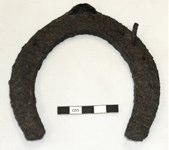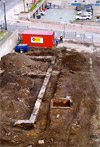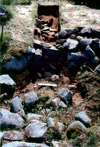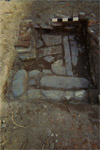S. A. Davis

Steve Davis - Professor Emeritus
Department of Anthropology
Saint Mary's University
Halifax, NS B3H 3C3
DPhil (Oxford), Professor.
Prehistory, archaeology of North America,
northeastern North America.
Phone:902-420-5628
Email: steve.davis@smu.ca
Recent Projects
Dr. Davis is contracted through his company, Davis MacIntyre and Associates, to complete many archaeological assessments, surveys, and excavations throughout the province each year. Below are a few examples of his work from recent years. Click the images below each for a larger photograph.
Point Pleasant Park
In February 2008, Dr. Davis was contracted with Davis Archaeological Consultants to conduct archaeological research on the history and current condition of the roads in Point Pleasant Park. Although many roads in the park were once used to access the important fortifications on the point, in 1866 a park committee was formed and by 1873 the War Department signed a formal lease to transform the area completely into a park. The Royal Engineers began to clear the forests and lay out walking paths for the public. Nearly a dozen new walking trails sprang up, while a few existing roadways were either modified or taken out all together. Many of the 1870s modifications remain to this day, and beneath the modern crushed gravel paths rest many historic roadbeds and walkways.
 |
 |
 |
 |
 |
Weir Bridge
In January 2007, Dr. Davis and Davis Archaeological Consultants Limited conducted an archaeological resource impact assessment of the Weir Bridge replacement project in South Rawdon, Hants County. A historical background study and field survey was conducted to determine if any potential archaeological resources existed within the development area. Although no excavations were conducted, at least two historic sites were encountered within or near the development area during the field survey. Their age, function, and extent are not known, although they are suspected to be related to the late nineteenth and early twentieth century occupation of the area by H. McKenzie. In addition to these historic sites, at least two areas of elevated potential for First Nations resources were encountered on the northwest and southwest side of the river, though no artifacts were recovered. (Click images to enlarge)
 |
 |
 |
 |
 |
Citadel High School Steam Line
Between December 2006 and June 2007, Dr. Davis and DAC conducted an archaeological resource impact assessment of the excavations for the Citadel High School Steam Line Installation. Excavation of the area turned up mid nineteenth to mid twentieth century artifacts, and remnants of at least two buildings. A mortared stone culvert was also discovered in situ, which was likely associated with nineteenth century diversion of Freshwater Brook, which once ran through this city block between Griffin's Pond in the Public Gardens and Egg Pond at the north commons (now the skateboard park). At some point in the nineteenth century, parts of Freshwater Brook were diverted and later channelled through culverts. Eventually, the brook was channeled through underground pipes, becoming a sewer. Little evidence of Freshwater Brook remains above ground today. (Click images to enlarge)
 |
 |
 |
 |
 |
The Frail House - Lloyd's Landing
In 2006, Dr. Davis and DAC Ltd. conducted an archaeological assessment for a residential development in Chester, Lunenburg County. This area was likely first settled by the ancestors of the Mi'kmaq and in the mid-eighteenth century, the lands were granted to a group of Boston immigrants. In 1844, the land directly under consideration was granted to the Frail family. The archaeological assessment resulted in the discovery and recording of several residential features including the dry stone foundation of the Frail House, a wooden and stone boat slip at the water's edge, along with a possible stone platform for a boat or fishing shed, a stone-bounded paddock, a possible well, barn, and an unidentified rectangular stone feature which was possibly a root cellar. (Click images to enlarge)
 |
 |
 |
 |
 |
Jefferson Property
Between 2004 and 2007, Dr. Davis was contracted under Davis Archaeological Consultants (DAC) Limited to conduct an archaeological impact assessment of the Jefferson Property in Fall River. The area included three features of interest: the remains of a house, a barn, and a well. About 1,000 artifacts were recovered from the site over the course of DAC's work. The deed search and historical research has shown that this property was occupied by one of Fall River's first black settlers by the mid-nineteenth century. Archaeological testing has confirmed that the site is of mid-nineteenth to twentieth century occupation. (Click images to enlarge)
 |
 |
 |
 |
 |
Salter's Gate
In March 2005, Dr. Davis was contracted with Davis Archaeological Consultants Limited to conduct an archaeological resource impact assessment for the Salter's Gate Marriott Hotel development in metropolitan Halifax. Historically, along Lower Water Street residences, businesses, and light industrial ventures combined to create the waterfront while the upper portion of the block along Hollis Street was home to several small businesses and row houses. A total of 34 archaeological features were discovered beneath the north end of this city block. Building foundations, backyard privies, middens, wells, a cistern, stables, drains, and cobble roadways (Hollis and Salter Streets) produced tens of thousands of artifacts. Items range from domestic glass and ceramic wares to shoe buckles, buttons, clay pipes, and a felt hat. Dr. Davis ensured that many high school and university students had the unique opportunity to participate in the excavation and artifact analysis. A selection of artifacts are now on display at the Hotel. (Click images to enlarge)
 |
 |
 |
 |
 |
Portobello Incline
Dr. Davis' investigation of archaeological resources at the Portobello Inclined Plane site on the Shubenacadie Canal with Davis Archaeological Consultants Limited began in October 2003, consisting of a background study and site survey, but no subsurface testing. On June 1, 1826 the Shubenacadie Canal Company was formed and construction began. The project faced repeated financial difficulties, and it was only by the summer of 1861 the steamer Avery first travelled the length of the Shubenacadie Canal from Halifax Harbour to Maitland and back 35 years after construction began on the canal. By the time the canal was complete railroads and other means of transportation had made the canal obsolete, and the waterway was never used to its full potential. Dr. Davis has conducted several studies and excavations on sections of the "Shubie" canal, the Portobello Incline being the most recent of these. (Click images to enlarge)
 |
 |
 |
 |
 |
The French Cellar
In May 2003, Dr. Davis and Davis Archaeological Consultants Limited (DAC) was awarded a contract to provide archaeological services in the assessment of a recorded site known as the "French Cellar" near Barrington Passage, Shelburne County. Several test units were excavated at the site, revealing an assortment of artifacts associated with domestic activity. The archaeological excavations combined with the historical background study suggest that the French Cellar site was occupied in the nineteenth century. The builder of the original structure is somewhat of a mystery as it is likely they started their occupancy as squatters. Although the historical record is limited, by using the process of elimination the most probable builder was Charles Villiers, a carder in Barrington. (Click images to enlarge)
 |
 |
 |
 |
 |
MetroPark
In January 2001, Dr. Davis and Davis Archaeological Consultants (DAC) Limited was contracted to conduct and archaeological resource impact assessment for a proposed parkade in downtown Halifax, bounded by Hollis and Granville Streets, between Salter and Sackville Streets. The archaeological investigations undertaken during this project revealed a total of twenty heritage resources consisting of privies, middens, and ash pits, as well as unidentified features. Based on the analysis of historical maps, it has been concluded that most of these features were likely associated with properties fronting on Granville Street throughout the nineteenth century although a few may have been related to residences or businesses on Salter and Hollis Streets. (Click images to enlarge)
 |
 |
 |
 |
 |
North River Saint Mary's
In the late 1990s, Dr. Davis was contracted with Davis Archaeological Consultants Ltd. to conduct an archaeological assessment of the 238 km Maritimes & Northeast Pipeline corridor from Goldboro, Guysborough County to the Nova Scotia - New Brunswick border in Cumberland County. Along with several historic period sites, two precontact First Nations sites were recorded and mitigated. The North River site on the North Branch of St. Mary's River in Guysborough County was identified as a result of a single surface find and was extensively excavated prior to construction of the pipeline. The artifact assemblage recovered from the site indicates that it dates to approximately 2150 to 1650 BP (Before Present). (Click images to enlarge)
 |
 |
 |
 |
 |